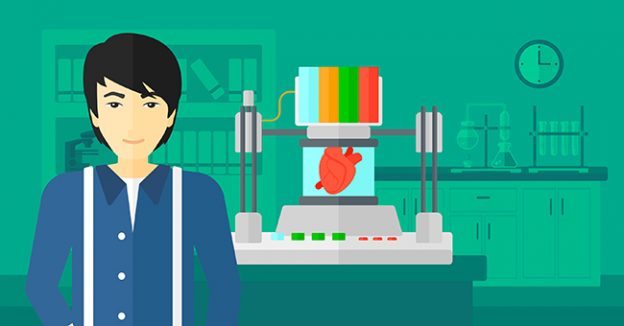Every once in a while, I come across a story in the news, about how a 3-D Printer is close to printing a human body part. The headlines are pretty sensational and they usually include a picture of an ear in a petri dish. If you read close, you realize that the application was pretty limited, it was an animal organ, and they can only create a few things that were already being done using other technologies. Disappointing…the ability to create your own replacement organs would be world-changing.
So how close are they to being able to 3-D Print, or bio-print, an organ for transplant? Actually, pretty close, clinical trial close, for simple body parts.
For any type of laboratory growth of a body part, you need cells that can grow into that part, stem cells, some sort of signal to the cells that they need to grow into the organ you want, and nutrients including blood and oxygen so the cells have the ingredients they need to divide and multiply. Researchers have been growing organs by taking donated material, like the cartilage from a cadaver ear, and covering it with stem cells from the patient. The cartilage shape is the primary signal to the stem cell. This goes a long way but it is still hard to get the nutrients needed and the signaling is not complete.
With 3-D Printing, you still have to provide stem cells from the patient, but the structure that the cells grow on can be created in a 3-D Printer. This is what 3-D Printers are great at, creating custom complex shapes. Initial attempts using 3-D Printers would create a structure, called a scaffold, and then cover the structure with the stem cells. More recent attempts mix the building material and the cells, providing a more integrated solution that grows faster and more uniformly while receiving better nutrients. They also include multiple materials, some for cell support and signaling and some for nutrient delivery.
Right now, the best examples that have been made are organs that are flat, tubes, or hollow. Things like skin, blood vessels, or bladders. These are relatively easy to do because they are thin structures. Researchers 3-D print a structure that supports the shape they want and then the cells grow on top. Complex shapes like those in a heart, or complex chemical processing organs like the liver, are beyond the ability of the technology, right now. But if a simple flat cell structure is needed, things are getting close.
What needs to happen to get to 3-D Printing human organs is better signaling to the cells and improved delivery of the nutrients. The signaling needs to move from just one type of cell to the ability to signal for multiple types, including the vascular structure needed to deliver nutrients. If you take a liver as an example, the 3-D Printed structure must grow the cells that carry out all the purification and chemical synthesis that a healthy liver provides, as well as the cells needed to keep blood flowing in and out of the liver. Signaling and nutrient delivery for that complex of a structure is not here yet. The structure can be 3-D Printed, but the cellular science is still being worked on.
However, in the near future, you can expect to have available skin grafts for burn victims. As well as reconstructive surgery grown from the patient’s own stem cells on a scaffold created with a 3-D Printer that also deposits the harvested and activated stem cells in the right location. Then, expect to see more complex structures like replacement bones, bladders, and transplantable veins and arteries. And after they decode the complex signaling, vital organs like the heart, liver, and pancreases should become available. So, the next time you see a picture of an ear growing in a petri dish, click on it and see how far the researchers have come.




